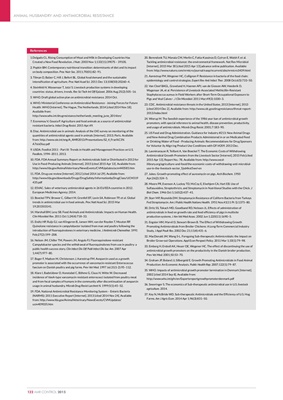
ANIMAL HUSBANDRY AND ANTIMICROBIAL RESISTANCE
122 AMR CONTROL 2015
References
1.delgado CL. Rising Consumption of Meat and Milk in Developing Countries Has
Created a New Food Revolution. J Nutr. 2003 Nov 1;133(11):3907S - 3910S.
2. Popkin BM. Contemporary nutritional transition: determinants of diet and its impact
on body composition. Proc Nutr Soc. 2011;70(01):82-91.
3. Tilman D, Balzer C, Hill J, Befort BL. Global food demand and the sustainable
intensification of agriculture. Proc Natl Acad Sci. 2011 Dec 13;108(50):20260-4.
4. Steinfeld H, Wassenaar T, Jutzi S. Livestock production systems in developing
countries: status, drivers, trends. Rev Sci Tech Int Off Epizoot. 2006 Aug;25(2):505-16.
5. WHO. Draft global action plan on antimicrobial resistance. 2014 Oct.
6. WHO. Ministerial Conference on Antimicrobial Resistance - Joining Forces for Future
Health. WHO [Internet]. The Hague, The Netherlands; 2014 [cited 2014 Nov 18].
Available from:
http://www.who.int/drugresistance/netherlands_meeting_june_2014/en/
7. Economou V, Gousia P. Agriculture and food animals as a source of antimicrobialresistant
bacteria. Infect Drug Resist. 2015 Apr;49.
8. Diaz. Antimicrobial use in animals: Analysis of the OIE survey on monitoring of the
quantities of antimicrobial agents used in animals [Internet]. 2013; Paris. Available
from: http://www.oie.int/eng/a_amr2013/presentations/s2_4_fran%c3%
a7oisdiaz.pdf
9. USDA. Feedlot 2011 - Part III: Trends in Health and Management Practices on U.S.
Feedlots, 1994-2011. 2013.
10. FDA. FDA Annual Summary Report on Antimicrobials Sold or Distributed in 2013 for
Use in Food-Producing Animals [Internet]. 2015 [cited 2015 Apr 13]. Available from:
http://www.fda.gov/animalveterinary/newsevents/cvmupdates/ucm440585.htm
11. FDA. Drug use review [Internet]. 2012 [cited 2014 Jul 29]. Available from:
http://www.fda.gov/downloads/drugs/drugsafety/informationbydrugclass/ucm319
435.pdf
12. ESVAC. Sales of veterinary antimicrobial agents in 26 EU/EEA countries in 2012.
European Medicines Agency; 2014.
13. Boeckel TPV, Brower C, Gilbert M, Grenfell BT, Levin SA, Robinson TP, et al. Global
trends in antimicrobial use in food animals. Proc Natl Acad Sci. 2015 Mar
19;201503141.
14. Marshall BM, Levy SB. Food Animals and Antimicrobials: Impacts on Human Health.
Clin Microbiol Rev. 2011 Oct 1;24(4):718-33.
15. Endtz HP, Ruijs GJ, van Klingeren B, Jansen WH, van der Reyden T, Mouton RP.
Quinolone resistance in campylobacter isolated from man and poultry following the
introduction of fluoroquinolones in veterinary medicine. J Antimicrob Chemother. 1991
Feb;27(2):199-208.
16. Nelson JM, Chiller TM, Powers JH, Angulo FJ. Fluoroquinolone-resistant
Campylobacter species and the withdrawal of fluoroquinolones from use in poultry: a
public health success story. Clin Infect Dis Off Publ Infect Dis Soc Am. 2007 Apr
1;44(7):977-80.
17. Bager F, Madsen M, Christensen J, Aarestrup FM. Avoparcin used as a growth
promoter is associated with the occurrence of vancomycin-resistant Enterococcus
faecium on Danish poultry and pig farms. Prev Vet Med. 1997 Jul;31(1-2):95-112.
18. Klare I, Badstübner D, Konstabel C, Böhme G, Claus H, Witte W. Decreased
incidence of VanA-type vancomycin-resistant enterococci isolated from poultry meat
and from fecal samples of humans in the community after discontinuation of avoparcin
usage in animal husbandry. Microb Drug Resist Larchmt N. 1999;5(1):45-52.
19. FDA. National Antimicrobial Resistance Monitoring System - Enteric Bacteria
(NARMS): 2011 Executive Report [Internet]. 2013 [cited 2014 Nov 24]. Available
from: http://www.fda.gov/animalveterinary/newsevents/cvmupdates/
ucm409035.htm
20. Berendonk TU, Manaia CM, Merlin C, Fatta-Kassinos D, Cytryn E, Walsh F, et al.
Tackling antimicrobial resistance: the environmental framework. Nat Rev Microbiol
[Internet]. 2015 Mar 30 [cited 2015 Apr 13];advance online publication. Available
from: http://www.nature.com/nrmicro/journal/vaop/ncurrent/abs/nrmicro3439.html
21. Aarestrup FM, Wegener HC, Collignon P. Resistance in bacteria of the food chain:
epidemiology and control strategies. Expert Rev Anti Infect Ther. 2008 Oct;6(5):733-50.
22. Van Cleef BAGL, Graveland H, Haenen APJ, van de Giessen AW, Heederik D,
Wagenaar JA, et al. Persistence of Livestock-Associated Methicillin-Resistant
Staphylococcus aureus in Field Workers after Short-Term Occupational Exposure to
Pigs and Veal Calves▿. J Clin Microbiol. 2011 Mar;49(3):1030-3.
23. CDC. Antimicrobial resistance threats in the United States, 2013 [Internet]. 2013
[cited 2014 Dec 2]. Available from: http://www.cdc.gov/drugresistance/threat-report2013/index.html
24. Wierup M. The Swedish experience of the 1986 year ban of antimicrobial growth
promoters, with special reference to animal health, disease prevention, productivity,
and usage of antimicrobials. Microb Drug Resist. 2001;7:183-90.
25. US Food and Drug Administration. Guidance for Industry #213: New Animal Drugs
and New Animal Drug Combination Products Administered in or on Medicated Feed
or Drinking Water of Food - Producing Animals: Recommendations for Drug Sponsors
for Voluntar ily Align ing Product Use Conditions with GFI #209. 2013 Dec.
26. Laxminarayan R, Teillant A, Van Boeckel T. The Economic Costs of Withdrawing
Antimicrobial Growth Promoters from the Livestock Sector [Internet]. 2015 Feb [cited
2015 Apr 13]. Report No.: 78. Available from: http://www.oecdilibrary.org/agriculture-and-food/the-economic-costs-of-withdrawing-anti-microbialuse-in-the-livestock-sector_5js64kst5wvl-en
27. Jukes. Growth-promoting effect of aureomycin on pigs. Arch Biochem. 1950
Apr;26(2):324-5.
28. Moore PR, Evenson A, Luckey TD, McCoy E, Elvehjem CA, Hart EB. Use of
Sulfasuxidine, Streptothricin, and Streptomycin in Nutritional Studies with the Chick. J
Biol Chem. 1946 Oct 1;165(2):437-41.
29. Starr MP, Reynolds DM. Streptomycin Resistance of Coliform Bacteria from Turkeys
Fed Streptomycin. Am J Public Health Nations Health. 1951 Nov;41(11 Pt 1):1375-80.
30. Dritz SS, Tokach MD, Goodband RD, Nelssen JL. Effects of administration of
antimicrobials in feed on growth rate and feed efficiency of pigs in multisite
production systems. J Am Vet Med Assoc. 2002 Jun 1;220(11):1690-5.
31. Engster HM, Marvil D, Stewart-Brown B. The Effect of Withdrawing Growth
Promoting Antimicrobials from Broiler Chickens: A Long-Term Commercial Industry
Study. J Appl Poult Res. 2002 Dec 21;11(4):431-6.
32. MacDonald JM, Wang S-L. Foregoing Sub-therapeutic Antimicrobials: the Impact on
Broiler Grow-out Operations. Appl Econ Perspect Policy. 2011 Mar 1;33(1):79-98.
33. Emborg H, Ersboll AK, Heuer OE, Wegener HC. The effect of discontinuing the use of
antimicrobial growth promoters on the productivity in the Danish broiler production.
Prev Vet Med. 2001;50:53-70.
34. Graham JP, Boland JJ, Silbergeld E. Growth Promoting Antimicrobials in Food Animal
Production: An Economic Analysis. Public Health Rep. 2007;122(1):79-87.
35. WHO. Impacts of antimicrobial growth promoter termination in Denmark [Internet].
2002 [cited 2014 Sep 8]. Available from:
http://www.who.int/gfn/en/expertsreportgrowthpromoterdenmark.pdf
36. Sneeringer S. The economics of Sub-therapeutic antimicrobial use in U.S. livestock
agriculture. 2014.
37. Key N, McBride WD. Sub-therapeutic Antimicrobials and the Efficiency of U.S. Hog
Farms. Am J Agric Econ. 2014 Apr 1;96(3):831-50.